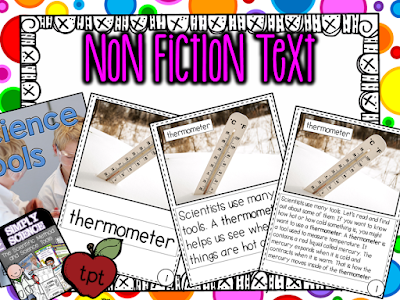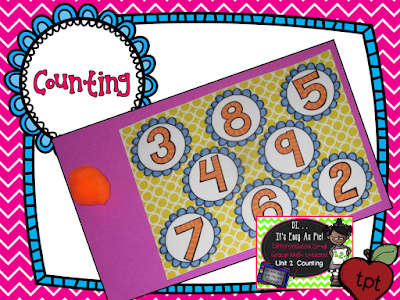Simply Science
Science is something that is often put on the back burner in kindergarten, right? We are so busy teaching the literacy and math standards it often leaves very little time for science. However, as a country we lag behind in science. So what is important about science? We need to build excitement, teach the scientific process, and show the connection to reading, writing and math!The first thing is to build excitement. Here is a picture of Megan, dressed and ready to be the made scientist. Each week we have a science box that contains our experiment of the week.
On Fridays, the kids wear their scientist jackets, nametags, and goggles as we open the science box to see what's inside.
The first time we opened the box we had this experiment. Over the course of the week, we worked through the scientific process, learning each step, as we conducted our experiment.
As we were learning the scientific process, we used our nonfiction readers to help us learn more. This is a great way to connect nonfiction text features to scientific information. By doing this, we are able to teach our children how to read scientific materials and use the features to help them. When I wrote this Science Tools reader, I wanted all my kids to be able to apply what they know. I made 3 levels of text (level 3 is great for the teacher). All 3 levels have the same pictures and the same nonfiction features. The only difference--the level of text!
During this session we also learned how to develop a science workshop. We start with a mini lesson that lasts about 10 minutes. This is where we teach the new concepts that slowly build over the week. Then the kids move to centers for 20 minutes. The centers are on a rotational system where they visit one center area each day. By the end of the week, they have been to all 5 centers.
Games Galore
Teachers love to play games! Here's my best secret...it isn't important to have a million games. If you teach the kids a few basic games, you can simply change the standard and change the clip art and they think it is a new game. This means that more time is spent learning the standard than how to play a new game.One game we play a lot for sight words is hangman. BUT, it doesn't have to be the traditional game. You can build anything...make a snowman, make Mr. Potato Head, etc!
Here are a few things I think of when I am playing:
- Children need to have a visual of the words you are choosing from. Place them in front of the word wall, give them a printed copy of the spelling words, etc.
- Each child needs a dry erase board to record their guess.
- Tell the children how many letters are in the word.
- Invite them to draw that many lines on their board.
- Read through the list of words with the children identifying the ones that have 3 letters.
- Children record their guess.
- Invite a child to guess a letter.
- Once the letter is recorded, or not recorded, the children must look at their word to determine if it still fits.
- Read through the list of words again. Identify the 3 letter words, with or without, the guessed letter.
- This means that more time is spent actually reading the words and looking at the features than at just random guessing!
Group, Partner, Team: Small Groups for Math Success
We all want to make the most of our small group time during math!We can use this structure to establish an effective math time: Mini Lesson, Work Time, and Share.
For example, this shape sorting activity is an easy mini lesson.
Then, the children move to centers. I set me room up with 5 centers. They visit one center each day, by Friday they have been to all five centers. Each center has a "have-to" activity like this button graph. To make the graph the rolled a dice and counted buttons. After making the graph, they wrote their analysis.
While children are working in centers, I pull small groups using a schedule like the one above. These groups are very flexible from week to week depending on what standard I am teaching. Each group has a common need.
This is an example of a game I play with my kids when we are learning to count! Super easy. The kids just toss a pom pom onto the game board. Then, they count up to the numeral where the pom pom landed.
One thing we don't want to do...plan a million activities. So it is super easy to adjust the game. Just use a different board with higher target numerals, or instead of playing the game as a small group, invite the children to play the game with partners.







































1 comment:
Post a Comment